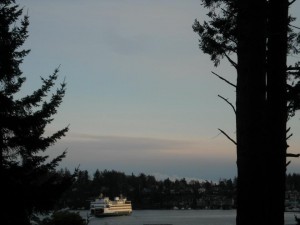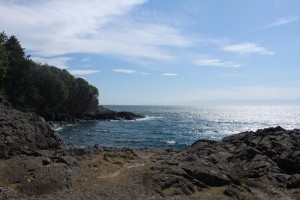The Friday Harbor Labs have a number of trails to explore, that weave and wind through the woods behind the labs. Rachel, Taya, and I decided to go explore some these trails one afternoon. As we were walking down muddy trail we spied a small tunnel that appeared to lead through a thicket. After bushwhacking through the gnarled tunnel, which had more thorns than we had anticipated, we emerged onto a breathtakingly beautiful meadow that overlooked the ocean. This was no ordinary meadow, it was the kind of meadow that you go to on a sunny day to make daisy chains. The ground was covered in a thick layer of emerald green moss that gently hugged us as we sat on it. Below the blissful meadow lay a small beach covered in soft rounded pebbles that made a pleasant clacking sound as we walked over them. As the sun began to sink lower in the sky it started to dawn on us that we had to get back to the trail. We didn’t want to go through the tunnel because it was unpleasant enough the first time. We decided to head due west towards the trail. Our zigzagging path through the woods took us on an adventure full of thorns and laughter. Hopefully next time we go to our amazing spot in the woods we can find a better way to get there!

This past week in class we each read and discussed a paper on sustainable fisheries. I chose a case study that evaluated the environmental impact of different varieties of feeds used at salmon farms. The main goal of this study was to determine if organic salmon feed had less of an environmental impact than the conventional salmon feed. The study used four different types of salmon feed. The LCA methodology was used to evaluate the environmental impact of each feed. Each ingredient was assessed on its environmental impacts from cradle-to-grave. They found that the organic ingredients outperformed the conventional ingredients in every category except ecotoxicity. This article really helped me grasp just how big of an impact farmed fish have on the environment. A good way to further the study would be to test the health impacts of organic vs. conventional  feed on the salmon.
Link to Feeding Farmed Salmon: Is Organic Better?
http://www.fcrn.org.uk/sites/default/files/Feeding_farmed_salmon_-_is_organic_better.pdf
Read More
My case study for this week centered on reducing bycatch of juvenile red snappers by shrimp trawls in the Gulf of Mexico. The paper is: Designing marine reserves to reduce bycatch of mobile species: a case study using juvenile red snapper (Lutjanus campechanus), by Diamond et al.

Red snapper from the Gulf of Mexico
The research team made use of geographic information system (GIS) to map fishery-independent trawl surveys done by the Southeast Area Monitoring and Assessment Program (SEAMAP) every summer and fall in the Gulf of Mexico from 1987 to 1997.
The paper attempts to asses whether there is a geographic pattern to the distribution of juvenile red snappers.
Diamond et al. analyzed juvenile red snapper distribution and examined “hot spots†with high concentration (intensity) and the predictability for the hotspot to reoccur in the same position over time (persistence). In designing marine reserves, one could designate no-trawling zones according to the desired level of intensity and persistence which correspond to percent or numerical bycatch-reduction goals.
In further consideration, given that red snappers are highly mobile and higher-intensity hotspots are often unpredictable, a no-trawling zone does not need to be permanent. Ideally, such a no-trawling zone could be fluid from year to year, in order to avoid trawling in higher-intensity hotspots.
For a no-trawling zone to be fluid, it would depend on how effectively this information could be disseminated in a timely manner. This could also apply to marine vessel no-go zones in the activity range of Southern Resident Killer whales. In the San Juan community, dissemination of information should be relatively easy due to wide availability of communication technology.
Read More
It is amazing how quickly a strange place full of unfamiliar faces can begin to feel like home. This experience only continues to get better.
In class this past week we looked at ecosystems from the “bottom upâ€. In a brief description, this means that you study ecology from the bottom of the food chain up to the top, examining the ecological differences in tropic levels. Combining this newer topic while still emphasizing sustainability science, we discussed case studies that look at sustainable fisheries.
My case study was “An ecosystem based approach for Alaska groundfish fisheriesâ€. I found this particular paper to be especially interesting because it focuses on managing fisheries from the perspective of the ecosystem instead of focusing on the economic benefits. The Alaskan groundfish fisheries management is known for being progressive and fairly sustainable. The total annual catch has been at 2 million tones for the last 20 years, an impressive statistic. The National Pacific Fishery Management Council wanted to include all aspects into the management process including: public participation, scientific research, comprehensive monitoring, gear restrictions, habitat conservation areas, and more. Conservative catch limits are highly emphasized and the total annual catch is always less than what the environment can sustain. This is a cautionary approach to fisheries management. The two aspects of the management plan that was most impressed with were the Marine Protected Areas and the examination of Marine Mammals and Seabirds. The Marine Protected Areas allocate specific locations that are important to the ecosystem and ban fishing from these areas, or lower the catch limits. This approach also takes into consideration the fisheries impacts on marine mammals and seabirds. Lowering by-catch rates, and decreasing negative interactions between the animals and the fishing boats are two of the goals for this aspect of system. I found this “ecosystem†approach to fisheries to be interesting and insightful. One important thing that I took away from our discussion of this paper is that although the management reports appear to be purely positive, every system has its downfalls.
Fisheries are incredibly important to understand right now in the world of killer whale

Perfection
conservation. We know that a lack of prey, specifically Chinook salmon, can have a huge impact on the population dynamics of the Southern Resident killer whales. Discussing a variety of fisheries management systems helped me have a better understanding of the current debates about salmon abundance and health here in the Pacific Northwest.
Yesterday we were lucky enough to have beautiful weather again. We spent our day off adventuring to Lime Kiln lighthouse and found a wonderful view atop the kiln itself. I never know what to expect here, this place has a way of surprising you all the time, but I am loving every minute of this adventure.
Read More






 Twitter
Twitter LinkedIn
LinkedIn Facebook
Facebook